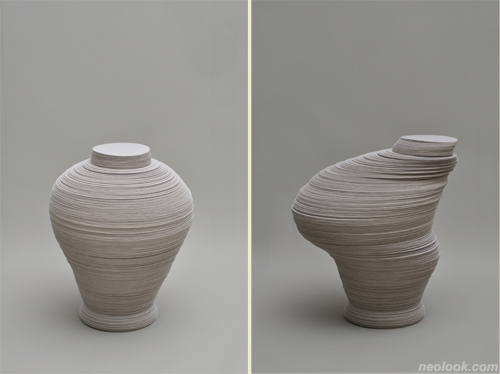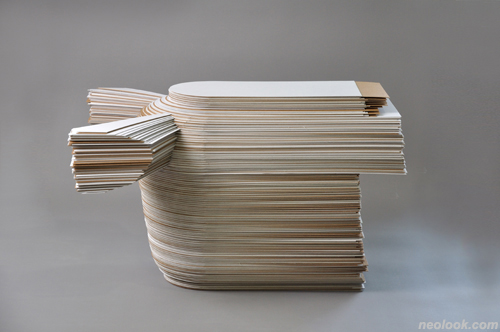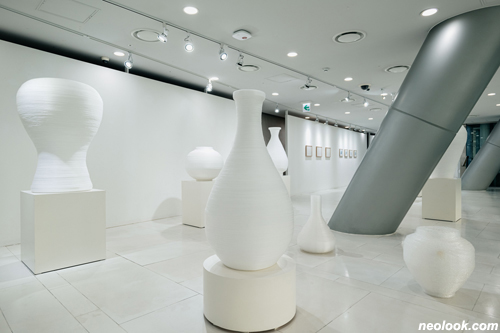- ● homepage
- ● archives
- ● restoration
- ● books
- ● big banners
- ● post board
- ■ neo's search
- ■ about us
- ■ 게재방법 안내
- 개인정보처리방침

- [email protected]
- Tel. 02_335_7922
- Fax. 02_335_7929
- 10:00am~04:30pm
- 월요일~금요일
- 3/3(월) 대체공휴일

Un_ceramic 언_세라믹 2020 서울시청 하늘광장 갤러리 공모선정작展
정혜숙展 / JUNGHYESOOK / 鄭惠淑 / installation.ceramic 2020_1228 ▶ 2021_0125
● 위 이미지를 클릭하면 네오룩 아카이브 Vol.20141120g | 정혜숙展으로 갑니다.
별도의 초대일시가 없습니다.
주최,주관 / 서울시청 하늘광장 갤러리
온라인 전시 skyplazagallery.com
서울시청 하늘광장 갤러리는 2020년 12월 28일부터 2021년 1월 25일까지 2020년 하늘광장 갤러리 공모선정작 전시 『언_세라믹』을 온라인 개최합니다. 작가 정혜숙은 주변의 환경과 사물로부터 포착한 형태와 사유를 드로잉과 설치 등의 다양한 매체로 가시화하는 작업을 해 오고 있습니다. 정혜숙 작가의 개인전 『언_세라믹』은 작가가 2012년부터 2015년까지 도자기의 조형과 제작 과정을 모티프로 진행한 작업을 서울특별시청에서 다시 선보이는 전시입니다. ● 우리가 흔히 박물관과 같은 장소에서 만나게 되는 완벽하고 정교한 형상의 도자기는 실제로는 수많은 변형을 거쳐 완성되는 끊임없는 노동의 산물입니다. 작가는 종이나 포장용 발포지와 같은 연약한 소재를 사용해 도자기의 아름답고 영원한 형태 이면에 존재하는 가변적인 시간성과 물질성을 표현하고 있습니다. 정혜숙 작가가 제작한 무겁지도, 깨지지도 않는 도자기는 더 이상 완전한 무엇은 아닙니다. 작가의 작업은 전통적인 도자의 속성을 탐구하면서도 도자의 재료가 아닌 것으로 도자기를 이야기합니다. 전시를 통해 과거와 현재의 역사가 교차하는 도시로서의 서울의 모습을 다시 발견하는 계기가 마련되기를 바랍니다. ■ 서울시청 하늘광장 갤러리

- 정혜숙_무제(Untitled)_종이에 연필_21×28cm_2012
세라믹, 도자기에 대한 나의 관심은 깨진 도자기 조각에서 시작되었다. 나는 쓸모없는 깨진 도자기 조각으로 나머지 형태를 상상하거나 소꿉놀이의 유용한 도구로 사용하며 어린 시절을 보냈다. 그런 과정에서 세라믹 조각은 오래된 것, 깨지는 것, 하지만 변하지 않는 것이라는 생각들을 갖게 되었다.

- 정혜숙_무제(Study of Time &Shape)_판지_37×30×30cm_2013
나의 세라믹 작업은 세라믹 소재를 주제로 한다. 세라믹을 직접적으로 다루기도 하지만 소재를 이해하는 과정에 관한 것들이다. 특히 '가야', 지금의 김해 지역 레지던시를 통해 한국 전통 도자기에 관심을 갖게 되었는데 그곳 박물관에서 마주한, 오랜 시간을 거쳐 온 도자기의 모습은 놀라울 정도로 고요하고 완벽했으며 아주 세련된 디자인의 것들이었다. 행여 그 도자기가 깨진 상태라 하더라도...

- 정혜숙_무제(Beveled Study of Time &Shape – Extrude)_ 판지_40×33×33cm_2013

- 정혜숙_무제(Jar_Study of Time &Shape)_판지_37×43×30cm_2013
부드러운 흙으로 도자기를 성형하는(만드는) 과정을 관찰할 기회가 있었다. 한 줌의 흙덩어리는 물레 위에서 도자기, 접시 등 그 흙이 만들어 낼 수 있는 최대의 결과물, 완벽한 형태로 다시 태어난다. 나는 그런 도자기를 종이, 드로잉, 세라믹 재료를 사용해 변형하거나 재현하며 그 형태를 이해하려고 한다. 한국 전통 도자기의 재발견은 우리나라 도자기에 대한 새로운 관심은 물론 다른 문화의 도자기들에도 관심을 갖게 만들었다. 어떻게 우리가 알고 있는 한국 전통 도자기의 형태가 만들어졌을까? 도자기의 형태는 각 문화마다 다른 고유한 형태를 지니는데 그 모양은 주로 도자기를 만드는 흙에 따라 달라질 수 있다. 물론 그 차이는 단순히 흙이라는 재료의 차이뿐 아니라 기후, 풍습, 생활환경 등 삶의 다양한 특성들을 반영하기 때문일 것이다. 아마 우리나라 전통 도자기도 우리 문화 고유의 특징을 담고 있기에 우리나라 사람들이 익숙하게 느끼고 그렇게 나에게도 애착과 관심을 불러일으키는 것 같다. 하지만, 나에게 그런 오랜 전통 도자기 형태는 변하지 않는 고정된 것이 아니라 늘 변하는 것이다. 나는 세라믹뿐만 아니라 여러 재료를 사용해 그런 변화를 실험하고 있다. ■ 정혜숙

- 정혜숙_언_세라믹(Un_ceramic)_폴리에틸렌 발포지_가변크기_2013

- 정혜숙_언_세라믹(Un_ceramic)_폴리에틸렌 발포지_가변크기_2013

Seoul City's Sky Plaza Gallery hosts its public contest selection exhibition Un_ceramic online from December 28, 2020, to January 25, 2021. Hyesook Jung, the contest-winning artist, has been working on visualizing the forms and thoughts captured from the surrounding environment and objects through various media, including drawings and installations. The exhibition, Un_ceramic presents her artworks created with the motif of ceramic-molding and forming process she had done from 2012 to 2015 once again at Seoul City Hall. ● The ceramics with a perfect and elaborate shape we often encounter at the museums are the fruit of constant works completed through a significant number of variations. Jung expresses variable 'time' and 'materiality' that exist behind the ceramics' beautiful and eternal forms using fragile materials, such as paper and packaging foam. The ceramics she created are not heavy nor infrangible, yet no longer perfect things. She explores the properties of traditional ceramics but describes ceramics with non-ceramic materials. The exhibition will allow you to discover Seoul as a city where past and present history coexists. ■ Sky Plaza Gallery, Seoul City Hall
My interest in ceramics started with broken pieces of pottery. I had a childhood to guess the rest of the pottery or use them for playing house. This experience made me think that ceramic can be old and broken, yet it never changes. ● My work is based on ceramic-materials. I directly handle ceramics, but it is more about understanding the properties of the materials. I got into traditional Korean ceramics through the residency of "Gaya Confederacy," the current Gimhae area. I ran into this time-honored pottery at the museum there, which was amazingly calm, perfect, and sophisticated. It was a little broken, though... ● I got a chance to watch the process of forming ceramics with soft clay. A handful of clay is reborn on a spinning wheel as the most excellent output that it can be as pottery, a plate, etc. I have tried to understand ceramics by transforming and recreating them with papers, drawings, and ceramic materials. The rediscovery of traditional Korean ceramics made me interested in the ceramics of other cultures as well. How did traditional Korean ceramics come into being as the way it looks nowadays? Each culture has a unique shape of pottery, which can vary mainly depending on the soil from which pottery is made. Of course, it may be because it reflects not only the differences in soil but also differences in various characteristics of climate, customs, and lifestyle. Perhaps traditional Korean ceramics are so familiar to us because it has Korean culture's unique features, which makes me get attached to it so much. For me, however, such a long-standing formation of traditional pottery is not fixed but always changing. I am experimenting with such changes using various materials as well as ceramics. ■ Jung Hyesook
Vol.20201228b | 정혜숙展 / JUNGHYESOOK / 鄭惠淑 / installation.ceramic

